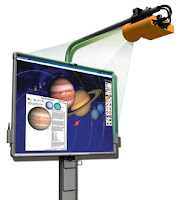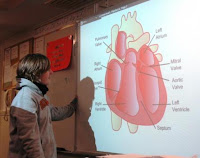
For this assignment I contacted Stacy Pugh, a Biology teacher at Vestavia Hills High School in Vestavia Hills, Alabama. I taught in the Birmingham area for 6 years and know of the reputation of this school system. The Vestavia school system takes pride in being on the cutting edge of technology and engaging instruction. Mrs. Pugh was very prompt in replying to my e-mail and was very eager to help. The first question I asked her was about the greatest and latest technology that she is using in her classroom. She was very helpful and she sounded very excited about the technology that she uses. According to Mrs. Pugh, Vestavia Hills has some of the most advanced educational technology tools available at this time. The Board of Education in this system just spent several million dollars outfitting each and every classroom with Promethean boards (pictured on the right) and the software to support them. Each teacher attended a two day mandatory training class. Mrs. Pugh referred to this class as a "crash course". Each teacher learned how to connect, turn on, and operate the actual hardware. She expressed her disappointment in the fact that the teachers did not have any time allowed to brainstorm with her peers and formulate ways to use the technology.

What is a Promethean Board (pictured at the left) and what does it do? Mrs. Pugh provided a little information about the Promethean Board and provided me with a website in order to discover more about this new technology. I visited two websites. The first website prometheanplanet.com is the site Mrs. Pugh suggested. This site is a for lack of a better word, "support" site. There are lesson plan links, flip chart link, and other links that I don't quite understand. This site was not as helpful as the second site I visited. Prometheanworld.com had everything I wanted and needed to know about this new technology. A Promethean Board is an interactive white board. This board was designed by teachers, so they could "transform the classroom into a truly interactive learning environment". The boards come with 2 Activpens that write like a pen but also can function as a mouse. There is a multitude of software packages to go with this board. With this new technology teachers can create engaging lessons that will capture their students and enhance the learning experience. These boards have battery free pens, wall mount brackets, low-glare, wire free technology,and best of all, award winning lesson development software that helps teachers create lessons in a click. Of course there are accessories to go with these boards, and Mrs. Pugh has a document camera that displays objects onto the board. She gave the example of a dissected flower. She can place the flower underneath the camera and point, draw, and label the parts of the flower on the board. This is a wonderful asset for a teacher, especially a science teacher during labs.
The second question I asked Mrs. Pugh was, " How often do you use technology in the classroom and how do your students respond to it?" She responded with a very simple answer. She told me that she uses it "every single day". According to Mrs. Pugh her students love the interactive aspect and she said that even the freshmen love to "play" with the boards. After visiting the websites above I can only dream of all the ways to use the Promethean board. What an excellent technological tool to use in engaging students in the learning process. Mrs. Pugh takes advantage of this technology on lab days. She is able to use the document camera to help her show students "live" examples of what they have been discussing in class. If a lab group has a particularly good example of a specimen, Mrs. Pugh can share it with the entire class with great ease. The Promethean board makes learning easy and adds novelty to the same old "stuff". The picture below shows a science class using the board to study the parts of the heart.

The last question I asked Mrs. Pugh was about support that was provided by her school system to help teachers with the technology that is being used. She was very positive in her response to this question. She said the teachers have excellent support. If a teacher has a need and contacts the appropriate person, that need is usually addressed within one school day. So when a teacher is making out his or her lesson plans and knows that they will need tech support for a specific lesson all they need to do is contact the technology coordinator. Teachers keep the coordinator aware of the lessons planned and the coordinator can be available to assist if needed. This component of technology usage is critical. Without a strong support system the teachers at Vestavia High School would have a difficult time using the wonderful tools available to them. There was no hint of frustration in my conversations with Mrs. Pugh. I could hear it in her voice ( I asked permission to call her at her school and she was happy to oblige). She was excited about the Promethean Board and I know that her excitement flowed over into her lessons and activities. Her students saw and felt this excitement and the chain reaction continues.
If you would like more information about Promethean Boards you can take a few minutes to watch this you tube video. This video was created by a group of teachers and students at Evangel Christian Academy. It is informative and entertaining.

